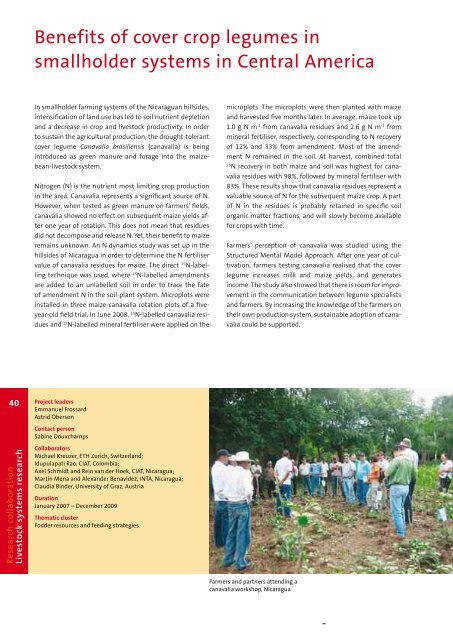NORTH-SOUTH CENTRE - ETH - North-South Centre North-South ...
NORTH-SOUTH CENTRE - ETH - North-South Centre North-South ...
NORTH-SOUTH CENTRE - ETH - North-South Centre North-South ...
You also want an ePaper? Increase the reach of your titles
YUMPU automatically turns print PDFs into web optimized ePapers that Google loves.
Benefits of cover crop legumes in<br />
smallholder systems in Central America<br />
In smallholder farming systems of the Nicaraguan hillsides,<br />
intensification of land use has led to soil nutrient depletion<br />
and a decrease in crop and livestock productivity. In order<br />
to sustain the agricultural production, the drought-tolerant<br />
cover legume Canavalia brasiliensis (canavalia) is being<br />
introduced as green manure and forage into the maizebean-livestock<br />
system.<br />
Nitrogen (N) is the nutrient most limiting crop production<br />
in the area. Canavalia represents a significant source of N.<br />
However, when tested as green manure on farmers’ fields,<br />
canavalia showed no effect on subsequent maize yields after<br />
one year of rotation. This does not mean that residues<br />
did not decompose and release N. Yet, their benefit to maize<br />
remains unknown. An N dynamics study was set up in the<br />
hillsides of Nicaragua in order to determine the N fertiliser<br />
value of canavalia residues for maize. The direct 15 N-labelling<br />
technique was used, where 15 N-labelled amendments<br />
are added to an unlabelled soil in order to trace the fate<br />
of amendment N in the soil-plant system. Microplots were<br />
installed in three maize-canavalia rotation plots of a fiveyear-old<br />
field trial. In June 2008, 15 N-labelled canavalia residues<br />
and 15 N-labelled mineral fertiliser were applied on the<br />
microplots. The microplots were then planted with maize<br />
and harvested five months later. In average, maize took up<br />
1.0 g N m -2 from canavalia residues and 2.6 g N m -2 from<br />
mineral fertiliser, respectively, corresponding to N recovery<br />
of 12% and 33% from amendment. Most of the amendment<br />
N remained in the soil. At harvest, combined total<br />
15<br />
N recovery in both maize and soil was highest for canavalia<br />
residues with 98%, followed by mineral fertiliser with<br />
83%. These results show that canavalia residues represent a<br />
valuable source of N for the subsequent maize crop. A part<br />
of N in the residues is probably retained in specific soil<br />
organic matter fractions, and will slowly become available<br />
for crops with time.<br />
Farmers’ perception of canavalia was studied using the<br />
Structured Mental Model Approach. After one year of cultivation,<br />
farmers testing canavalia realised that the cover<br />
legume increases milk and maize yields, and generates<br />
income. The study also showed that there is room for improvement<br />
in the communication between legume specialists<br />
and farmers. By increasing the knowledge of the farmers on<br />
their own production system, sustainable adoption of canavalia<br />
could be supported.<br />
40 Project leaders<br />
Emmanuel Frossard<br />
Astrid Oberson<br />
Contact person<br />
Sabine Douxchamps<br />
Research collaboration<br />
Livestock systems research<br />
Collaborators<br />
Michael Kreuzer, <strong>ETH</strong> Zurich, Switzerland;<br />
Idupulapati Rao, CIAT, Colombia;<br />
Axel Schmidt and Rein van der Hoek, CIAT, Nicaragua;<br />
Martin Mena and Alexander Benavidez, INTA, Nicaragua;<br />
Claudia Binder, University of Graz, Austria<br />
Duration<br />
January 2007 – December 2009<br />
Thematic cluster<br />
Fodder resources and feeding strategies<br />
Farmers and partners attending a<br />
canavalia workshop, Nicaragua
















